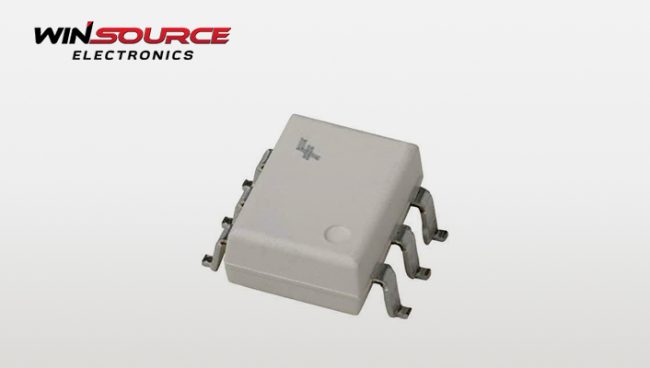
In deep space exploration, nuclear energy control, and high-reliability industrial applications, signal isolation technology plays a critical role not only in system functional safety but also as a fundamental pillar of overall architectural design. Faced with extreme environmental challenges such as high radiation, temperature, and pressure, traditional optocouplers’ interference resistance, power consumption, and integration capabilities gradually fall short of engineering demands. The HCPL-6751 is specifically designed to address this trend. As a high-performance, four-channel optocoupler that integrates radiation resistance and a wide operating temperature range, it provides a robust barrier for electronic systems operating in harsh environments.
Technical Characteristics: Setting a New Standard for Isolation Systems
The HCPL-6751 utilizes GaAsP-based light-emitting devices combined with highly sensitive optical detection components to completely isolate electrical signals to optical signals and back to electrical signals. Each channel offers 1500VDC isolation voltage, effectively blocking common-mode interference and enhancing the system’s ability to withstand sudden disturbances.
This device supports simultaneous multi-channel isolation and significantly saves PCB space—its four-in-one integrated design reduces board-level area by approximately 40% compared to two dual-channel optocouplers. Additionally, its radiation tolerance reaches 1×10^12 rad(Si)/s, far exceeding many industrial standards. It is an ideal component for tasks involving radiation effects, such as deep space exploration and high-energy particle experiments.
Its control current threshold is extremely low, requiring only 0.5mA to drive the output, and its Current Transfer Ratio (CTR) is 1500%. This makes it suitable for low-power embedded devices like microcontrollers (MCUs) or FPGA platforms. This characteristic is fundamental in edge computing and satellite subsystems, where high-efficiency signal isolation must be achieved within strict power constraints.
Key Differences and Selection Advice: A Practical Comparison with the HCPL-5230
While the HCPL-5230 is also a high-performance optocoupler, the HCPL-6751 clearly excels in extreme conditions due to its higher multi-channel integration and superior radiation protection capabilities:
- Channel Integration: The HCPL-6751 integrates four isolated channels in a single chip, reducing the layout complexity and interference issues associated with multiple device combinations.
- Radiation Resistance: Compared to the HCPL-5230’s 5×10^11 rad(Si)/s standard, the 6751’s radiation tolerance is over twice as high, making it more suitable for orbital spacecraft or nuclear physics experimental systems.
- Packaging Flexibility: The 6751 is available in FP-16 ceramic flat-pack and LCCC packaging, supporting high-density mounting and leadless soldering environments, and meeting complex packaging layout requirements.
Typical Applications: The “Invisible Hero” in Industry Scenarios
- Aerospace and Defense Systems: Used for satellite attitude control, signal acquisition, and redundancy link isolation, providing stable shielding against electromagnetic interference and cosmic radiation during on-orbit operations.
- Nuclear Energy Facility Control: Ensures stable isolation of control commands and sensor signals in control cabinets exposed to strong neutron radiation and frequent high-voltage fluctuations.
- Medical Life Support Systems: For instance, intensive care unit (ICU) equipment, isolation helps prevent patient touch points from exposure to high-voltage leakage risks.
- 5G and High-Reliability Communication Systems: Acts as a signal rectifier and power isolator between communication base station power supplies and main controllers, effectively reducing noise interference.
Engineering Usage Recommendations: How to Maximize the Performance of the HCPL-6751
- Recommended Wiring Distance: To ensure strong isolation, the distance between input and output traces should be kept ≥8mm to avoid the risk of breakdown.
- Thermal Design Considerations: In high-density mounting applications, additional heat sink pads or thermal adhesive sheets can be added to the device’s bottom to reduce package temperature rise.
- Load Current Control: To enhance device reliability and lifespan, it is recommended that the continuous operating current be kept within 80% of the rated value.
- ESD Protection: Static protection should be observed during installation or transport, and storage humidity should be controlled within the 30-70% range.
Future Trends and Design Considerations
As high-performance embedded systems demand better radiation resistance and higher system integration, optocouplers are evolving in two key directions: first, the integration of self-diagnosis functionality, with built-in BIST (Built-In Self-Test) to provide real-time feedback on isolation channel status; second, support for SEU (Single Event Upset) fault tolerance, further enhancing system stability and safety.
There are already design cases where the HCPL-6751 is used for four-channel PWM signal isolation in satellite power modules, with measured error rates below 10^-9 in high-radiation simulated environments, and the system’s mean time between failures (MTBF) exceeding 100,000 hours, demonstrating excellent mission stability.
Conclusion: From Reliable Isolation to a Cornerstone of System Trustworthiness
The HCPL-6751 is not merely a high-performance optocoupler; it represents the foundation of trust for future critical systems operating in high-risk environments, ensuring signal clarity and precise control. With its superior radiation resistance, excellent power efficiency, and packaging adaptability, the HCPL-6751 has become an indispensable component in deep space explorers, nuclear energy platforms, and cutting-edge industrial equipment. As a global leading component service platform, WIN SOURCE offers factory-certified HCPL-6751 documentation, ECAD package models, selection support, and one-stop delivery services, helping engineers confidently select and ensure reliable usage in every system design.
© 2025 Win Source Electronics. All rights reserved. This content is protected by copyright and may not be reproduced, distributed, transmitted, cached or otherwise used, except with the prior written permission of Win Source Electronics.

COMMENTS